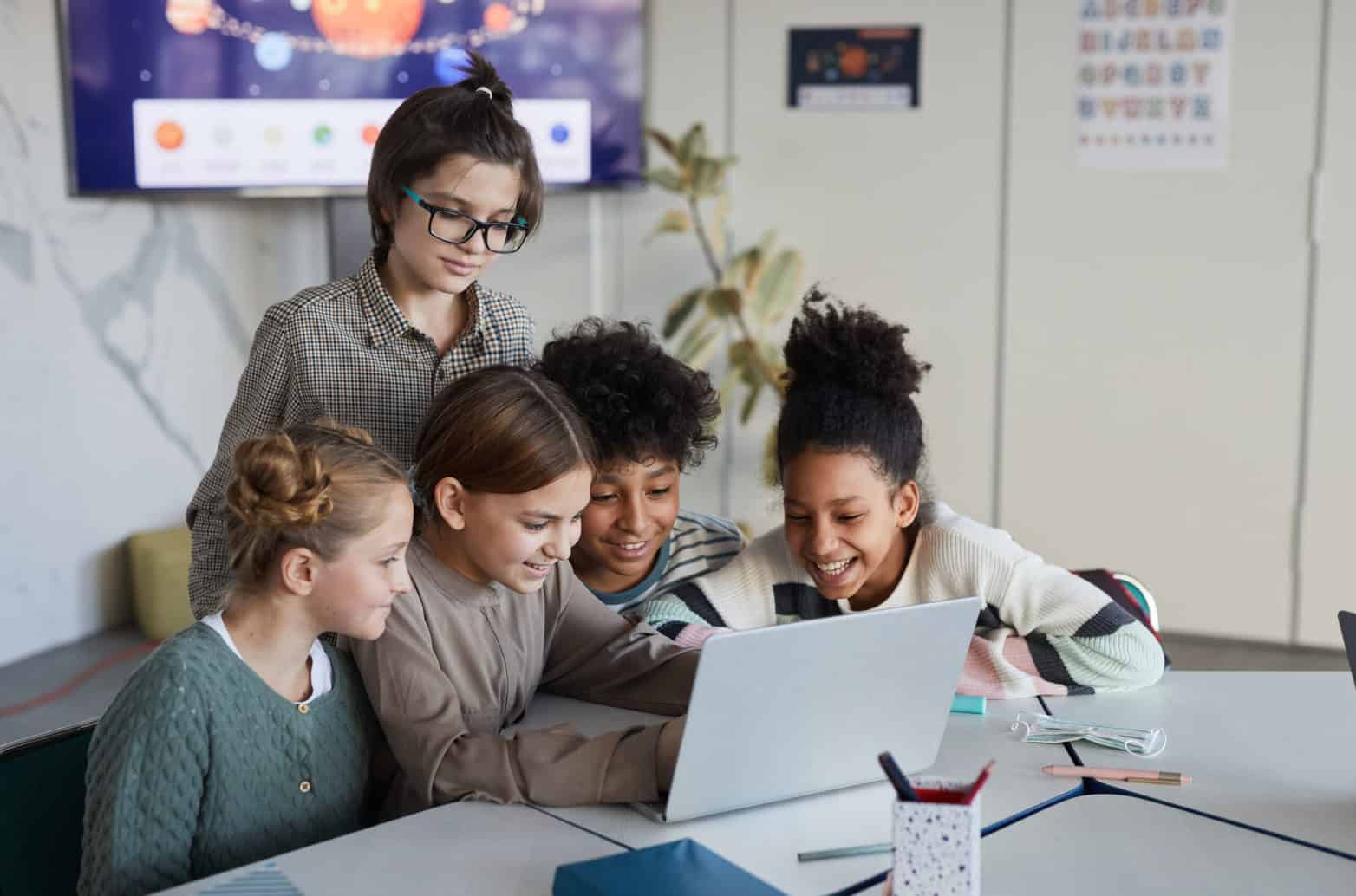Author: Abigail Amoako Kayser, Ph.D. is an Assistant Professor at the College of Education at California State University, Fullerton in the Department of Elementary and Bilingual Education. She is a Fulbright Scholar and a former elementary teacher. Through her research and teaching, she aims to advance our understanding of how teachers ensure equitable, just, and anti-racist educational experiences and outcomes for historically resilient students in the U.S. and Ghana.
Tina Starks is a Designer for Student Achievement Partners where she works in community with inspiring colleagues and educators to collectively design resources, tools, and spaces of learning aimed at humanizing education for transformational impact. Her lived and professional experiences bring intentionality to emphasize the belonging and affirming of Black students and English learners in our schools.
Understanding sociopolitical consciousness in the classroom
“Education either functions as an instrument which is used to facilitate integration of the younger generation into the logic of the present system and bring about conformity or it becomes the practice of freedom, the means by which men and women deal critically and creatively with reality and discover how to participate in the transformation of their world.” (Paulo Freire, Pedagogy of the Oppressed)
Critical consciousness, conceivably the pinnacle of culturally relevant pedagogy (CRP), often proves challenging for many teachers to implement, leading many to leave it out of their instructional practice. However, this practice of critical thinking is a tool for students and teachers to examine the world and provides context and relevance for students to feel empowered to envision possibilities in transformative ways.
In her groundbreaking article “But That’s Just Good Teaching! The Case for Culturally Relevant Pedagogy,” Dr. Gloria Ladson-Billings proposes that it is not “enough for students to choose academic excellence and remain culturally grounded if those skills and abilities represent only an individual achievement.” She asserts that teachers who practice in a culturally relevant way must engage in the tenet of sociopolitical consciousness, also known as critical consciousness, which she describes as “the ability to take learning beyond the confines of the classroom using school knowledge and skills to identify, analyze, and solve real-world problems.”
This practice of sociopolitical consciousness is also highlighted in Dr. Bettina Love’s writing, that without critical consciousness, we face the danger of turning “schools into places that mirror society instead of improving it.” By weaving critical consciousness into instructional practices, teachers provide a pathway for students “to understand that if we have to learn with each other we should also learn about each other so we can bring each other up,” as suggested by Christopher Emdin in For White Folks Who Teach in the Hood… and the Rest of Y’all Too: Reality Pedagogy and Urban Education.
The role of curriculum, intervention, and assessment
The current state of K-12 school curricula, intervention, and assessment follows a long history of skill-based learning and measure with minimal consideration for cultural relevance. Student assessments are often leveraged to measure success toward standardized benchmarks. The outcomes of these assessments lead to interventions and the adoption of new curricula that are aimed at building academic skills. Unfortunately, the primary focus on skill-based learning neglects to address the criticality necessary for students to develop a strong sense of their identities. In addition, students miss the opportunity to gain an understanding of how they can maneuver themselves beyond the classroom in meaningful and productive ways. In other words, critical literacy goes beyond academic skill-building and extends into a student’s understanding of all forms of injustices and their ability to recognize how they can impact change. Dr. Geneva Gay warns that while some programs may increase achievement levels for students of color, “…their effect may not stand the test of time or be as comprehensive as they claim. They may inadvertently cause students to compromise their ethnic and cultural identity to attain academic achievement.” (Gay, “Culturally Responsive Teacher: Theory, Research, & Practice”)
In order to maximize the effectiveness of any curriculum, the content must provide personalized context and cultural relevance for students to serve as a medium through which critical consciousness can insert criticality into the learning experience. However, ignoring the social and cultural backgrounds of diverse students increases the risk of resistance and communicates a lack of relevance in their lives. Introducing critical consciousness into the curriculum invites students to consider their interactions with peers as well as the world outside of the classroom. Students begin to consider ideas around equity and justice as it impacts not only themselves but others as well. In this way, the learning experience offers students the freedom to explore creative and transformative ideas about how they can take social action for the betterment of the communities in which they exist. With this purposeful engagement, students are empowered to traverse their identities and beliefs to disciplines and cultures beyond their own, leading them to improve upon their academic performance. Critical consciousness allows students to finally arrive at the answer to the proverbial question: “Why am I learning this?” They discover that their learning can make the world a better place.
“Criticality is the capacity to read, write, and think in ways of understanding power, privilege, social justice, and oppression, particularly for populations who have been historically marginalized in the world.” (Gholdy Muhammad, 2018)
However, despite the growing research that highlights the benefits of critical consciousness in the classroom, many educators face challenges to fully implement practices of criticality.
One reason teachers may hesitate to engage in this practice is the assumption of the political nature of this tenet. However, Gorksi and Swalwell, in Equity Literacy for All, remind us that the notion that schools are not and should not be a political space is a common misconception. Rather, Hess and Mcavoy suggest that creating a “political classroom” offers students the opportunity to learn “the process of deliberation that is the major skill being taught. And then, through deliberation, students are learning about the issues,…a process that is, at its heart, democratic.”
Practicing in a culturally relevant way is the embodiment of the thousand-mile journey beginning with a single step. It’s a challenging process where teachers who are doing the work of culturally relevant teaching never truly feel a sense of mastery or completion. Becoming a culturally relevant educator requires noticing, listening, being open to new perspectives, and interrogating one’s past. It requires deep empathy and intentionality on the teacher’s end to see the brilliance in minoritized students. For example, in an empathy interview with a first-grade teacher, Ms. Smith insists that we: “…make[s] sure that our actions as educators are never putting barriers in front of these students, and in fact, we are pushing them to shatter glass ceilings, regardless of any label that society may put on them.”
What are we learning?
In our conversations with educators, one teacher noted that it was important for students to think critically “about what they’re learning and [have] real discussions about the relevance of what we’re talking about in their own daily lives.” What we see here is that critical consciousness unfolds in the classroom in nuanced ways. Teachers elevate the identities and life experiences of students that help them to have agency to communicate what is individually relevant. Another teacher reminded us that, in creating a space for critical consciousness, it is important for teachers to “give students the ability to be critical and allow them to be.” This teacher further explained that “I think that’s a skill that students need to practice because they will find that the world isn’t necessarily set up for everyone to be critical.”
Here, we highlight some of the salient practices shared with us by teachers in the empathy interviews:
- Critical Thinking with Peers “I think a really strong classroom has students who are thinking critically about what they’re doing and not just sitting and doing worksheets all the time. I think it would be noisy and I think students would be collaboratively working together towards a common goal. There would probably be an emphasis on writing, storytelling, or being able to speak and explain your thinking in a variety of different ways.”
- Relevance to Student Lives “I feel thinking critically about what they’re [students] learning [in school] and having real discussions about the relevance to their [students] own daily lives”
- Sociopolitical Context In and Out of the Classroom “I think the political context that we’re living in today is different than when it was when I started teaching. When I first started teaching, I thought that what happens outside of school is separate from what happens in school. I’ve learned that that doesn’t really serve the kids quite well. Kids are aware of everything from kindergarten age and so now that I have learned more about this practice [culturally relevant pedagogy], I am helping students to fully realize versions of themselves. I wish I had been taught to be more critical.”
- Historical Context and Multiple Perspectives “When we read the book, The Things They Carried by Tim O’Brien, I never just made it about Tim O’Brien’s story. I always brought up how different groups of people were drafted. We watched real footage of news stories and the televised draft. And then I brought in conversations from my [Black] uncles who pointed out that they were only supposed to draft one person from a family but in Black neighborhoods, multiple people from families were drafted…the whole neighborhood was drafted. But if you went to the White side of town there would be maybe just one person per family. This is our history and this is real life. So this is a fictional book, but it relates to you.”
The benefits of adding critical consciousness in the classroom
In gathering information for this project, we noted that teachers who practice CRP often display a deep understanding of why there is a need for justice and what fuels injustice. Furthermore, they need to understand the intersectional nature of injustice; more specifically, it must be a reminder of the words of Dr. Martin Luther King Jr., who said, “Injustice anywhere is a threat to justice everywhere.” In this tenet, educators must understand how systemic and institutional racism fuels discrimination and oppression and how that leads to an opportunity gap for many students. This understanding and mindset help teachers to avoid blaming their students and their communities for perceived shortcomings.
When introducing critical consciousness in the classroom, the learning environment becomes more than a space for acquiring academic skills and rigor. Students begin to engage in discourse that allows them to question injustices, challenge oppressive practices, and actively participate in problem-solving for the betterment of the communities in which they exist, both in and outside of school. Critical consciousness invites students and educators alike to consider the perspectives of multiple identities when reading and analyzing text. This approach to critiquing and interrogating content humanizes education by expanding its purpose to the larger context of society. As students develop critical consciousness, they also gain an understanding of the significance of their own identities and the power of their influence.





